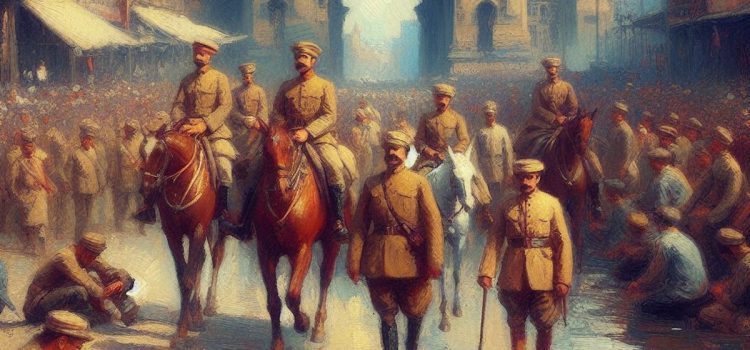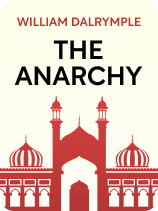

This article is an excerpt from the Shortform book guide to "The Anarchy" by William Dalrymple. Shortform has the world's best summaries and analyses of books you should be reading.
Like this article? Sign up for a free trial here.
How did India come under British governance? What role did the East India Company play? When and how did the Indian people cast off colonial rule?
In The Anarchy, historian William Dalrymple explains the expansion and consolidation of British power in India. He does this by tracing the ascent of the East India Company from a modest group of merchants to the imperialist superpower.
Keep reading to learn the background of British colonial rule in India.
British Power in India
The history of the expansion and consolidation of British power in India starts with Europe’s interest in the subcontinent in the 16th century. By this time, the Mughal empire in India was one the richest on earth, second only to Ming China. Dalrymple explains that English traders were attracted to India’s vast wealth.
European traders stood to gain enormous profits by trading with India directly and cutting out the traders in between. The English East India Company (EIC) formed to trade with India in 1600. Queen Elizabeth I signed its charter, granting a trade monopoly that excluded rival English merchants over most of eastern and southern Asia.
Dalrymple asserts that, in the 17th century, the EIC was constrained by the power of the Mughals and carefully deferred to their authority. Dalrymple explains that the Mughals commanded enormous armies and the British were in no position to cross them. The British took military action against the Mughals only once during this time.
Around the early 18th century, the Mughal empire began to collapse. The independent provinces stopped sending tribute, undermining the empire’s finances. This fractured India into competing regional powers, inaugurating a period of war and instability.
While the EIC didn’t cause the collapse of the Mughal empire, Dalrymple asserts that it became the primary beneficiary. No longer constrained by the powerful Mughals, the EIC expanded its trading operations and military capacity. The EIC set its sights on Bengal, a wealthy province on India’s northeastern coast. The EIC began its rise to power in Bengal by first building up military capacity and then challenging the Mughal rulers.
Dalrymple notes that, though the EIC had now carried out two successful coups, it still faced a significant gap in legitimacy. Fortunately for the company, a potential ally had made his way to Bengal and was interested in talks. Shah Alam was a young Mughal prince who had been heir to the throne in Delhi. While the EIC had power without legitimacy, Shah Alam had legitimacy without power. Their complementary needs suggested a natural alliance.
According to Dalrymple, the EIC would face one more challenge to establishing complete rule in Bengal: an alliance between three Mughal princes. The three princes assembled an enormous force and marched toward Bengal. However, the EIC managed to repel their attack, largely due to a crack in the princes’ alliance. Dalrymple explains that Shah Alam wasn’t fully committed to the alliance. With the alliance fragmented, the EIC launched a successful counteroffensive and defeated Shuja’s army, cementing its rule in Bengal.
Dalrymple states that the EIC established rule over Bengal by carefully maintaining the old Mughal hierarchies. The tax collectors, soldiers, petty officials, and law agents were all the same as before. However, EIC men now sat at the top of every hierarchy. A second key component of the EIC’s governance consisted of systematically draining wealth from the Bengal economy. Dalrymple argues that the EIC’s policies of wealth extraction had disastrous consequences for Bengal. In less than a decade of EIC rule, Bengal, once the wealthiest province in India, became one of the poorest. This led to two catastrophic events: the Great Bengal Famine and a financial crisis in Europe.
The British Parliament realized it needed to control the damage done by the EIC’s financial policies. Dalrymple explains that the Parliament’s response fundamentally reshaped the relationship between the EIC and the British government. This set in motion a process of gradually increasing government oversight and control that would continue over the next century.
Bengal wasn’t the only part of India where the EIC had established itself by the time of the Bengali Famine and Britain’s reassessment of its interests. Dalrymple states that the company had also begun asserting itself on the larger stage of regional powers vying for control of the greater Indian subcontinent. Parallel empire building that paved the way for government control when Parliament ratcheted up its oversight of the EIC in the ensuing years. Specifically, the EIC rose to power in greater India through a series of wars against two major powers: the Mysore Sultanate and the Maratha Confederacy.
The victory over the Mysore territory led to a vast expansion of the EIC’s power. The company’s territory more than doubled and it appropriated much of the Sultanate’s wealth. Furthermore, it assimilated troops from Tipu’s former armies into its own, growing its total forces to over 155,000 troops, a greater force than the entire military of Britain. In the Anglo-Maratha wars, the EIC marched on Delhi and captured it from the Marathas. Dalrymple argues that this was the turning point in the war: Though the Marathas would continue resisting, the fall of Delhi established the EIC as the dominant power in the region.
A private corporation, initially created for trade, now controlled half a million square miles and ruled over millions of subjects. Dalrymple explains that, in 1803, the EIC consolidated its power by once again installing a puppet ruler who could lend a veneer of legitimacy to its regime. To do so, the company turned once more to Shah Alam, the exiled Mughal prince who had played a similar role in legitimizing the company’s rule in Bengal and by now was an old man. The EIC tried to publicly frame its rule as a “reinstatement” of Shah Alam and a restoration of Mughal power—though, in reality, the old Mughal state was now firmly under British command.
Dalrymple asserts that the EIC’s consolidation of power ultimately cleared the way for British rule in India. The British Parliament had already started questioning the wisdom of trusting Britain’s most important colony to a private company, and the increasing government oversight slowly transformed the company’s administration into a state-run enterprise. The British government officially took over in 1858, after a war for Indian independence stirred fears that the company was losing control of its empire. Nonetheless, Dalrymple asserts, the fall of Delhi truly marked the culmination of the EIC’s rise to power. The period of anarchy following the collapse of the Mughal empire was ending, and a new era of British dominion was beginning.
| Indian Resistance to British Colonialism The establishment of British dominion in India also marked the beginning of a long struggle for Indian Independence from British rule. Here we’ll review some of the key events that ultimately led to Indian independence. In 1857, Indian soldiers in the EIC’s Bengal army organized an armed rebellion against their English officers. The revolt was incited by a perception that the English were using beef and pork lard to grease the soldiers’ gun cartridges, angering Hindus and Muslims (since these religions condemn those products, respectively). The rebels succeeded in taking back Delhi, and rebellions spread throughout the subcontinent. In 1885, India formed a national congress. While still lacking the authority to overturn British policy, the Indian National Congress served as a platform for Indians to advocate for their rights and eventually organize around the cause of independence. During the early 20th century, independence movements spread across the subcontinent. Influenced by the leadership of Mahatma Gandhi, these movements practiced nonviolent resistance, including boycotts, demonstrations, political and economic non-cooperation, and other forms of civil disobedience. These movements eventually succeeded in overturning British rule and achieving independence for modern India and Pakistan in 1947. |

———End of Preview———
Like what you just read? Read the rest of the world's best book summary and analysis of William Dalrymple's "The Anarchy" at Shortform.
Here's what you'll find in our full The Anarchy summary:
- The rise of the English East India Company during the 17th and 18th centuries
- How a trading company came to rule most of the Indian subcontinent
- The background, historical context, and fallout from the events in the book






